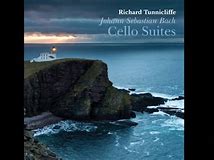
Richard Tunnicliffe. Bach Cello Suites. Linn Records CKD396 Released 2012 Dual layer CD/SACD.
Recorded at St George’s Church, Chesterton Cambridge UK. Recording over approximately 7 days between Oct 2010 and Nov 2011.
Cello played attributed to Leonhard Maussiell, c.1720 and for sixth Suite, cello piccolo by Pierre Malahar, 1726
Pitch A= 415Hz.
CD layer used to audition this recording. NB. This performance appears to have been recently re-issued with catalogue no CKR 396 and is possibly CD only. Therefore, as I have not listened in SACD or Hi res download, I have not commented on the sound quality of this recording. However, on CD it is fine with no issues.
The Cellist.
Richard Tunnicliffe is an eminent exponent of baroque music. Especially so in the UK having released notable recordings of concertos by a previously almost unheard of composer called John Garth. Garth was born in the county of Durham in 1721. These are fine pieces in their own right and well worth a listen.
So what does Tunnicliffe bring to the much better known works of J.S. Bach? In a nutshell, I would say a very safe pair of hands. This may seem a little like damning with faint praise. Even derogatory, as it suggests the performance may lack interest or fail to grip the listener. What I mean by the expression, “Safe pair of hands” is that he provides what for me is a faultless performance. However, no seat of the pants moments or frippery!
The Recording.
Needless to say, it is a historically informed performance. Significantly, it has all the typical features of steady rise and fall in phrasing, well articulated fast passages, and a really good sense of forward momentum. The tone is rich and sonorous, slightly scratchy at times due to gut strings. Generally, however, with a sweet sound in the upper registers particularly in the sixth Suite where the cello piccolo is played.
In this performance, the tempos used for each movement feel very correct. Just the right amount of variation within each movement to emphasise shape and contrast.
A highlights for me is the first Prelude. This has a seductive homely feel as if being invited to sit in front of an open fire. The second Prelude has a very sad sombre atmosphere giving a sense of real despair. The fourth Prelude was interesting. It has an almost metronomic pace at beginning and end, sandwiching what feels to be an almost free form middle passage.
The Allemandes particularly benefit from Tunnicliffe’s ability to convey rhythmic sense within very complicated writing timing wise, never stagnating or losing its purpose.
Conclusion.
In conclusion, an unqualified recommendation for anyone looking for a historically informed performance and a good entry point for someone wanting to explore the Cello Suites.
The added bonus are excellent notes by Tunnicliffe about the Suites and with no mention of Anna Magdalena!
His sub section titled Solo Instrumental performance impresses with the quote: “we must decide which notes are ornamental and which structural, so as to offer clear signposts to guide the listener through the music. By a process of unconscious suggestion akin to word-association, (he/she) supplies the harmonic context for him or herself, creating the sense of a much bigger musical picture. It is this constant two-way exchange which, over and above the undeniable surface beauty of the music, gives these compositions their enduring fascination.”
Charles